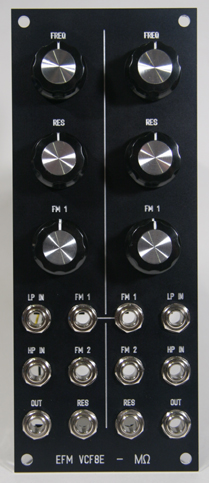
MS20 style VCF
Built on VCF8E pcb from EFM
Bourns pots
Front Panel Express engraved panel 2U x 5U (8.75" x 3.5")
Two MS20 "clone" filters in one module.
Each section is tweaked to oscillate with Res setting at 12'.
Turning futher clockwise will change the pitch and color.
Turned all the way clockwise the oscillating tone is turned to garbled noise.
Beautiful!
Price: $250.00
See below for details, pics, and sound samples
If you'd like to purchase this module or have any other questions/requests contact me at:
megaohm1@gmail.com
I have two available. One in black and one in medium bronze.
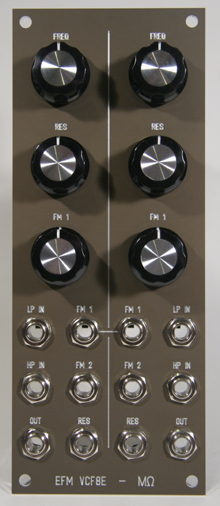
Controls
FREQ - manual cutoff frequency
RES - Resonance control (sometimes called Emphasis).
Filter will oscillate once turned past 12 o'clock.
FM 1 - level control for FM 1 signal.
Controls for the second VCF are a mirror of the first
Inputs and Output
Functions of the second filter's jacks are the same except where noted.
LP - audio input for Low Pass response of filter.
HP - audio input for High Pass responsee of filter.
FM 1 - CV input for control of cutoff frequency.
The FM 1 jack for the LEFT VCF is normalled to the FM 1 jack for the RIGHT VCF. Plugging into the RIGHT FM 1 jack will break that connection
FM 2 - CV input for control of cutoff frequency.
RES - CV input for control of Resonance level.
OUT - Final output.
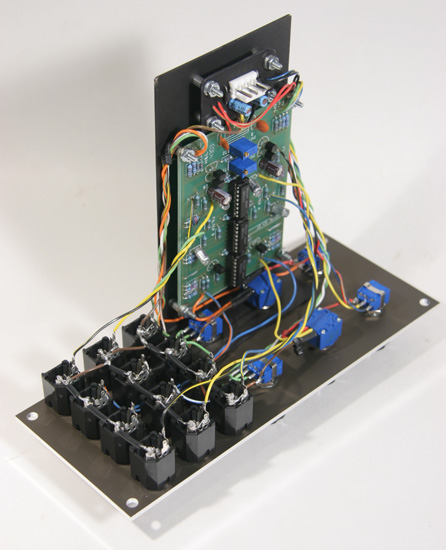
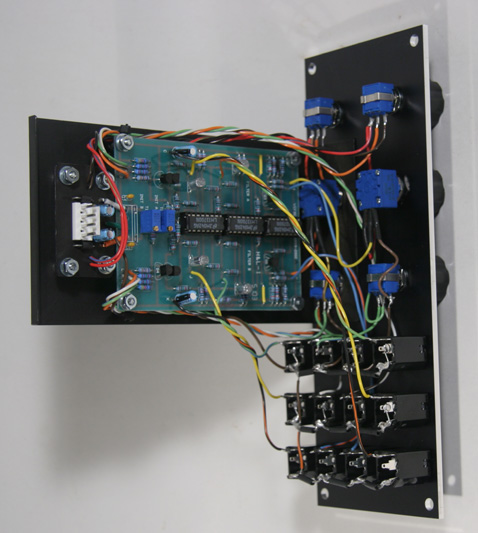
Important Notes
First off, does this filter sound like the Korg MS20 VCFs? I don't know! I've never had the opportunity to play one. I have heard sound samples of other clones and have built a few other MS20 clone designs, too. They sound tame compared to these two! Though the others may sound "truer" to the original MS20 VCF sound, I find this circuit much more exciting.
Each module consists of two identical voltage controlled filters. Each VCF is completely independent of the other (except for the RIGHT FM 1 jack, which is make-and-break connected to the LEFT VCF FM 1 jack).
The filters can be operated in parallel by mixing their outputs with an external mixer. They can be run in series by patching the output of one to the input of the other. Series connection will give a steeper slope.
The high pass input is interesting in that it can be used simultaneously with the LP input. Even more interesting is that this jack gives you direct access to one of the filter caps. If you "dummy" plug it the cutoff frequency will change and the output signal will be boosted. If you then start turning the Res pot clockwise, the oscillations will become very distorted (and loud). Res pot full up and it's a huge, crunchy sound. Tell the guitar player to go home :)
One more cool thing, you can influence the cutoff frequency by dummy plugging with a patch cord and then holding the other end in your hand. If you roll your finger (squeeze your hand shut, whatever) across the tip and sleeve you become the "ground" and the cutoff frequency dips down. It doesn't span the whole Freq range, but it can be used effectively to add a little (literal) "human" touch.
PCP bracket is 6.25" long (round it up to 7" to make room for the power cable). Make sure it will fit in your cabinet.
Power is +/-15V. 4pin MTA.156 header.
power cord is included
I can etch an adapter board for Synthesizers.com users (tell me when ordering).
LP and HP inputs expect +/-5V signals (10Vp-p)
Control inputs expect 0-5V
Values higher or lower than these are fine as long as you stay within the power supply range (+/-15V)
Sound Samples
These audio samples are, for the most part, unedited. Long, too!
They can get a little tedious but I'm hoping you patch heads will give me a little slack. They do show off some of the many flavors this filter can produce.
Most of the samples are simply a VCO patched into the MS20 module. Modulation is supplied by LFOs, envelopes, and my hand.
These samples exploit and show off the resonce characteristics of the VCF. It can also sound very smooth and transparent when the resonance pot is kept under 11 o'clock. In fact, they work well as utilitarian lowpass or highpass 2 pole filters when the RES is at minimum.
Fading VCO high RES
Shows the effect of the input fighting with the VCF resonance.
RES pot is set so the VCF is oscillating. The VCO is turned on and off by an envelope. With the VCO fully on the VCF oscillation is surpressed. As the VCO fades in volume the VCF oscillation fights its way back to a stable tone determined by the FREQ pot.
Barberpole effects
This sample turns things around. If the VCF is oscillating and the FREQ pot is turned low, we get an LFO from the VCF. In this patch the VCF has no audio input. It is set to oscillate and the frequency is swept by a slow moving LFO patched to FM 1. The output of the VCF is patched to the FM input of a VCO. Most of the time the VCF is oscillating at audio rates only dipping into LFO range for short periods. Further into the sample you'll hear more low rate controls from the VCF (around 1:35).
This patch has an interesting barberpole effect. It's made with only three modules: VCO, one section MS20 VCF, LFO
Starts with unmodulated high pitched VCO output tone. Ends with that, too.
endure the monotany
Lots of hand manipulation. Shows off a bunch of flavors.
More Resonance!
Starts off with plain VCF oscillation tones. Key CV, envelope, and hand modulation.
Noise
Cross modulation patch. Output from the left VCF is patched to LP IN of the Right VCF section.
The out of the right section is patched to LP IN of the first VCF section.
Modulation from LFOs, SH, and hand.
Endless hours of fun if you like this sort of thing (I do).
No VCOs or other audio scorces were used. It's all resonating filters.
Sequenced
I forgot the patch
I'll get some low resonance samples up soon (if need be).
Note the metal color text/etching.
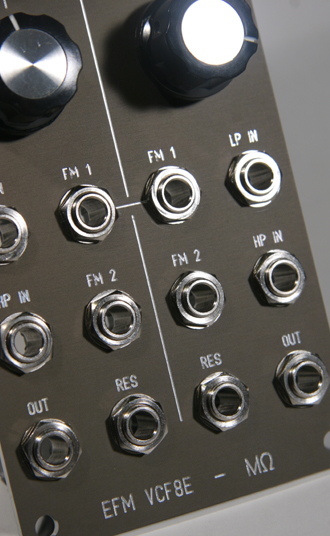
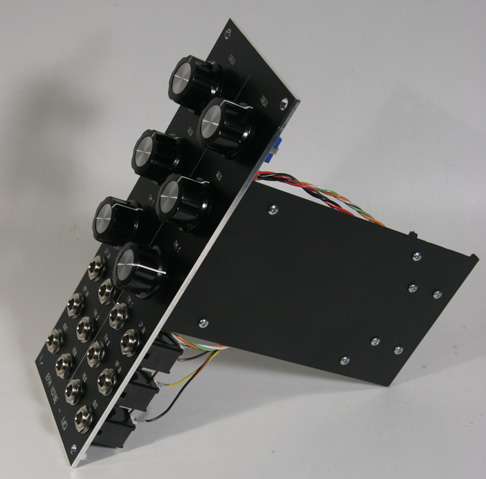
home





